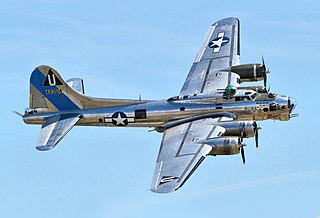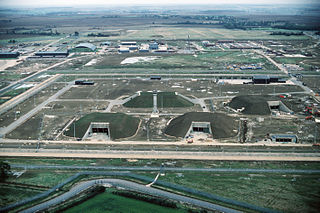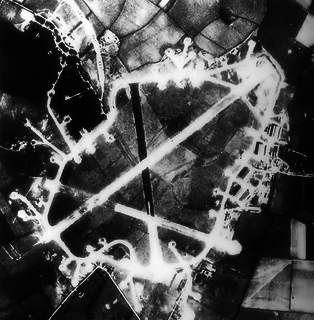
The Boeing B-17 Flying Fortress is a four-engined heavy bomber developed in the 1930s for the United States Army Air Corps (USAAC). Competing against Douglas and Martin for a contract to build 200 bombers, the Boeing entry outperformed both competitors and exceeded the Air Corps' performance specifications. Although Boeing lost the contract because the prototype crashed, the Air Corps ordered 13 more B-17s for further evaluation. From its introduction in 1938, the B-17 Flying Fortress evolved through numerous design advances, becoming the third-most produced bomber of all time, behind the four-engined Consolidated B-24 Liberator and the multirole, twin-engined Junkers Ju 88.
The Pathfinders were target-marking squadrons in RAF Bomber Command during World War II. They located and marked targets with flares, which a main bomber force could aim at, increasing the accuracy of their bombing. The Pathfinders were normally the first to receive new blind bombing aids like Gee, Oboe and the H2S radar.

Royal Air Force Molesworth or more simply RAF Molesworth is a Royal Air Force station located near Molesworth, Cambridgeshire, England with a history dating back to 1917.

The 306th Flying Training Group is a unit of the United States Air Force, assigned to Air Education and Training Command (AETC). The group is stationed at the United States Air Force Academy (USAFA) near Colorado Springs, Colorado.

Royal Air Force Station Polebrook or more simply RAF Polebrook is a former Royal Air Force station located 3.5 miles (5.6 km) east-south-east of Oundle, at Polebrook, Northamptonshire, England. The airfield was built on Rothschild estate land starting in August 1940.

Royal Air Force Bovingdon or more simply RAF Bovingdon is a former Royal Air Force station located near the village of Bovingdon, Hertfordshire, England, about 2.5 miles (4.0 km) south-west of Hemel Hempstead and 2.5 miles (4.0 km) south-east of Berkhamsted.

Royal Air Force Thurleigh or more simply RAF Thurleigh is a former Royal Air Force station located 5 miles (8.0 km) north of Bedford, Bedfordshire, England. Thurleigh was transferred to the United States Army Air Forces Eighth Air Force on 9 December 1942 and designated Station 111, and used for heavy bomber operations against Nazi Germany.

The Schweinfurt–Regensburg mission was a strategic bombing mission during World War II carried out by Boeing B-17 Flying Fortress heavy bombers of the U.S. Army Air Forces on August 17, 1943. The mission was an ambitious plan to cripple the German aircraft industry; it was also known as the "double-strike mission" because it entailed two large forces of bombers attacking separate targets in order to disperse fighter reaction by the Luftwaffe. It was also the first American "shuttle" mission, in which all or part of a mission landed at a different field and later bombed another target before returning to its base.

The Memphis Belle is a Boeing B-17F Flying Fortress used during the Second World War that inspired the making of two motion pictures: a 1944 documentary film, Memphis Belle: A Story of a Flying Fortress and the 1990 Hollywood feature film, Memphis Belle. It was one of the first United States Army Air Forces B-17 heavy bombers to complete 25 combat missions, after which the aircrew returned with the bomber to the United States to sell war bonds. In 2005 restoration began on the Memphis Belle at the National Museum of the United States Air Force at Wright-Patterson AFB in Dayton, Ohio where, since May 2018, it has been on display. The B-17 used in the 1990 feature film is housed at the National Warplane Museum in Geneseo, New York.
Homer William Bigart was an American reporter who worked for the New York Herald Tribune from 1929 to 1955 and for The New York Times from 1955 to his retirement in 1972. He was considered a "reporter's reporter" and an "enduring role model." He won two Pulitzer Prizes as a war correspondent, as well as most of the other major journalism awards.
Paul Manning was an American broadcast journalist. He worked closely with Edward R. Murrow during World War II as a correspondent for CBS Radio, and with the Mutual Broadcasting System later on in the war.
Robert Perkins Post worked as a reporter for the New York Times during World War II. He was part of a group of eight reporters, known as the Legion of the Doomed or the Writing 69th, selected to fly bomber missions with United States Eighth Air Force.

The 45th Air Division is an inactive United States Air Force unit. Its last assignment was with Eighth Air Force at Pease Air Force Base, New Hampshire. It was inactivated on 14 June 1989.

The 303rd Air Expeditionary Group is a provisional United States Air Force unit. In 2011, it was assigned to United States Air Forces Europe to activate or inactivate as needed.

The Battle of the Heligoland Bight was the first "named" air battle of the Second World War, which began the longest air campaign of the war, the Defence of the Reich. On 3 September 1939, the United Kingdom declared war on Nazi Germany after the German invasion of Poland, which started the European War. The British did not assist Poland by land or sea but RAF Bomber Command flew several missions against German targets. A number of these air raids were directed at Kriegsmarine warships in German ports to prevent their use in the Battle of the Atlantic. With the front lines static between September 1939 and May 1940, a period known as the "Phoney War" set in, with little fighting on land or in the air.

The 359th Bombardment Squadron was a United States Air Force unit. It was last assigned to the 303d Bombardment Wing, stationed at Davis–Monthan Air Force Base, Arizona. It was inactivated on 15 June 1964.

The 360th Bombardment Squadron is an inactive United States Air Force unit. It last was assigned to the 303d Bombardment Wing, stationed at Davis-Monthan Air Force Base, Arizona. It was inactivated on 15 June 1964.
The term "thousand-bomber raid" was used to describe three night bombing raids by the Royal Air Force against German cities in summer 1942 during World War II. The term was a propaganda device, whereby Arthur Harris reached the number of bombers by including not only bombers that were currently operational as part of RAF Bomber Command, but also aircrews from Operational Training Units to accumulate a force of 1,000 bombers as a demonstration of the RAF's power. The bulk of the bomber force was twin-engined medium bombers such as the Vickers Wellington. As the number of heavy bombers in the RAF increased, greater tonnage could be dropped on a target with fewer aircraft. Later mass RAF raids used between 400 and 700 four-engined bombers, and on some nights, Bomber Command could send two 400-bomber forces to separate targets. Operation Gomorrah in 1943 and the attack on Dresden in 1945 each used nearly 800 aircraft. Nearly 900 were sent to Berlin in February 1944; with aircraft on other missions that night more than 1,000 bombers were active, but 1,000 bombers were never sent against a single target after June 1942.












